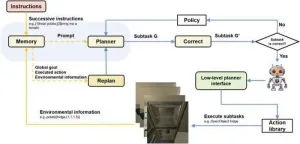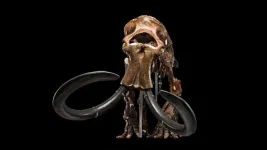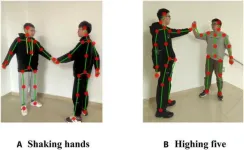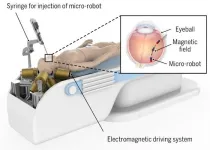(Press-News.org) For centuries, civilizations have used naturally occurring, inorganic materials for their perceived healing properties. Egyptians thought green copper ore helped eye inflammation, the Chinese used cinnabar for heartburn, and Native Americans used clay to reduce soreness and inflammation.
Flash forward to today, and researchers at Texas A&M University are still discovering ways that inorganic materials can be used for healing.
In two recently published articles, Dr. Akhilesh Gaharwar, a Tim and Amy Leach Endowed Professor in the Department of Biomedical Engineering, and Dr. Irtisha Singh, assistant professor in the Department of Cell Biology and Genetics, uncovered new ways that inorganic materials can aid tissue repair and regeneration.
The first article, published in Acta Biomaterialia, explains that cellular pathways for bone and cartilage formation can be activated in stem cells using inorganic ions. The second article, published in Advanced Science, explores the usage of mineral-based nanomaterials, specifically 2D nanosilicates, to aid musculoskeletal regeneration.
“These investigations apply cutting-edge, high-throughput molecular methods to clarify how inorganic biomaterials affect stem cell behavior and tissue regenerative processes,” Singh said.
The ability to induce natural bone formation holds promise for improvements in treatment outcomes, patient recovery times and the reduced need for invasive procedures and long-term medication.
“Enhancing bone density and formation in patients with osteoporosis, for example, can help mitigate the risks of fractures, lead to stronger bones, improve quality of life and reduce healthcare costs,” Gaharwar said. “These insights open up exciting prospects for developing next-generation biomaterials that could provide a more natural and sustainable approach to healing.”
Gaharwar said the newfound approach differs from current regeneration methods that rely on organic or biologically derived molecules and provides tailored solutions for complex medical issues.
“One of the most significant findings from our research is the ability of these nanosilicates to stabilize stem cells in a state conducive to skeletal tissue regeneration,” he said. “This is crucial for promoting bone growth in a controlled and sustained manner, which is a major challenge in current regenerative therapies.”
Gaharwar recently received a research program (R01) grant from the National Institute of Dental and Craniofacial Research to continue developing biomaterials for clinical applications. With the grant, Gaharwar will use inorganic biomaterials in conjunction with 3D bioprinting techniques to design custom bone implants for reconstructive injuries.
“In reconstructive surgery, particularly for craniofacial defects, induced bone growth is crucial for restoring both function and appearance, vital for essential functions like chewing, breathing and speaking,” he said. “Inducing bone formation has several critical applications in orthopedics and dentistry.”
Former biomedical engineering graduate student, Dr. Anna Kersey ’23, was the lead author for the article published in Acta Biomaterialia and biomedical engineering graduate student Aparna Murali was the lead author for the follow-up article published in Advanced Science.
“This approach not only bridges ancient practices with modern scientific methods but also minimizes the use of protein therapeutics, which carry risks of inducing abnormal tissue growth and cancerous formations,” Gaharwar said. “Collectively, these findings elucidate the potential of inorganic biomaterials to act as powerful mediators in tissue engineering and regenerative strategies, marking a significant step forward in the field.”
By Bailey Noah, Texas A&M Engineering
END
Ancient medicine blends with modern-day research in new tissue regeneration method
Inspired by past medical uses of natural, inorganic materials, researchers have discovered a new technique for tissue regeneration using mineral-based nanomaterials.
2024-05-31
ELSE PRESS RELEASES FROM THIS DATE:
Navigating new horizons: Pioneering AI framework enhances robot efficiency and planning
2024-05-31
In a groundbreaking study published in Cyborg Bionic Systems, researchers from Shanghai University have unveiled a new artificial intelligence framework that revolutionizes the way robots interpret and execute tasks. The "Correction and Planning with Memory Integration" (CPMI) framework leverages large language models (LLMs) to improve the efficiency and effectiveness of robots performing complex, instruction-based tasks.
Traditionally, robots required explicit programming and extensive data to navigate ...
Tirzepatide for weight reduction in Chinese adults with obesity
2024-05-31
About The Study: In Chinese adults with obesity or overweight, once-weekly injection with tirzepatide 10 mg or 15 mg resulted in statistically significant and clinically meaningful weight reduction with an acceptable safety profile.
Corresponding Author: To contact the corresponding author, Xiaoying Li, M.D., email li.xiaoying@zshospital.sh.cn.
To access the embargoed study: Visit our For The Media website at this link https://media.jamanetwork.com/
(doi:10.1001/jama.2024.9217)
Editor’s Note: Please see the article for additional information, including other authors, author contributions and affiliations, conflict of interest and financial ...
U of T researchers discover ‘trojan horse’ virus hiding in human parasite
2024-05-31
An international team led by researchers at the University of Toronto has found a new RNA virus that they believe is hitching a ride with a common human parasite.
The virus, called Apocryptovirus odysseus, along with 18 others that are closely related to it, was discovered through a computational screen of human neuron data – an effort aimed at elucidating the connection between RNA viruses and neuroinflammatory disease. The virus is associated with severe inflammation in humans infected with the ...
Clues to mysterious disappearance of North America’s large mammals 50,000 years ago found within ancient bone collagen
2024-05-31
50,000 years ago, North America was ruled by megafauna. Lumbering mammoths roamed the tundra, while forests were home to towering mastodons, fierce saber-toothed tigers and enormous wolves. Bison and extraordinarily tall camels moved in herds across the continent, while giant beavers plied its lakes and ponds. Immense ground sloths weighing over 1,000 kg were found across many regions east of the Rocky Mountains.
And then, sometime at the end of the Last Ice Age, most of North America’s megafauna disappeared. How and why remains hotly contested. Some researchers believe the arrival of humans was pivotal. Maybe the animals were hunted and eaten, or maybe humans just altered ...
Revolutionizing interaction recognition: The power of merge-and-split graph convolutional networks
2024-05-31
In a significant advancement for robotics and artificial intelligence, researchers at Chongqing University of Technology, along with their international collaborators, have developed a cutting-edge method for enhancing interaction recognition. The study, published in Cyborg and Bionic Systems, introduces the Merge-and-Split Graph Convolutional Network (MS-GCN), a novel approach specifically designed to address the complexities of skeleton-based interaction recognition.
Human interaction recognition plays a crucial role in various applications, ranging from enhancing human-computer interfaces ...
Do shape-memory alloys remember past strains in their life?
2024-05-31
Endowed with the power of memory, certain alloys can magically return to their original shape when heated or deformed. However, the repeated back-and-forth between the original and new configuration may leave permanent imprints on the alloy’s microscopic features, which could then impact its ability to reversibly transform shape. Thus, unraveling the impact of the strain history on these alloys’ functionality is essential to improving predictive capabilities, but it has not received enough attention.
To fill this knowledge gap, the National Science Foundation ...
A novel electromagnetic driving system for 5-DOF manipulation in intraocular microsurgery
2024-05-31
The electromagnetic driving systems are proposed for the flexible 5-DOF magnetic manipulation of a micro-robot within the posterior eye, enabling precise targeted drug delivery. A research team has presented a novel electromagnetic driving system that consists of eight optimized electromagnets arranged in an optimal configuration and employs a control framework based on an active disturbance rejection controller (ADRC) and virtual boundary.
The team published their findings in Cyborg and Bionic Systems on Mar 23, 2024.
Intraocular microsurgery has witnessed a transition from the utilization of conventional handheld surgical tools to the adoption of robot-assisted surgery, owing ...
Researchers identify a genetic cause of intellectual disability affecting tens of thousands
2024-05-31
New York, NY [May 31, 2024]—Researchers at the Icahn School of Medicine at Mount Sinai and others have identified a neurodevelopmental disorder, caused by mutations in a single gene, that affects tens of thousands of people worldwide. The work, published in the May 31 online issue of Nature Medicine [DOI: 10.1038/s41591-024-03085-5], was done in collaboration with colleagues at the University of Bristol, UK; KU Leuven, Belgium; and the NIHR BioResource, currently based at the University of Cambridge, UK.
The findings will improve clinical diagnostic ...
EMBARGOED: Nearly one-third of US adults know someone who’s died of drug overdose
2024-05-31
Losing a loved one to drug overdose has been a common experience for many Americans in recent years, crossing political and socioeconomic divides and boosting the perceived importance of the overdose crisis as a policy issue, according to a new survey led by researchers at the Johns Hopkins Bloomberg School of Public Health.
A nationally representative survey of more than 2,300 Americans, fielded in spring 2023, suggests that 32 percent of the U.S. adult population, or an estimated 82.7 million individuals, has lost someone they know to a fatal drug overdose. ...
Mediterranean diet adherence and risk of all-cause mortality in women
2024-05-31
About The Study: Higher adherence to the Mediterranean diet was associated with a 23% lower risk of all-cause mortality in this cohort study. This inverse association was partially explained by multiple cardiometabolic factors.
Corresponding Author: To contact the corresponding author, Shafqat Ahmad, Ph.D., email shafqat.ahmad@medsci.uu.se.
To access the embargoed study: Visit our For The Media website at this link https://media.jamanetwork.com/
(doi:10.1001/jamanetworkopen.2024.14322)
Editor’s Note: Please see the article for additional information, including other authors, author contributions and affiliations, conflict of interest ...
LAST 30 PRESS RELEASES:
Correlation between cancer cachexia and immune-related adverse events in HCC
Human adipose tissue: a new source for functional organoids
Metro lines double as freight highways during off-peak hours, Beijing study shows
Biomedical functions and applications of nanomaterials in tumor diagnosis and treatment: perspectives from ophthalmic oncology
3D imaging unveils how passivation improves perovskite solar cell performance
Enriching framework Al sites in 8-membered rings of Cu-SSZ-39 zeolite to enhance low-temperature ammonia selective catalytic reduction performance
AI-powered RNA drug development: a new frontier in therapeutics
Decoupling the HOR enhancement on PtRu: Dynamically matching interfacial water to reaction coordinates
Sulfur isn’t poisonous when it synergistically acts with phosphine in olefins hydroformylation
URI researchers uncover molecular mechanisms behind speciation in corals
Chitin based carbon aerogel offers a cleaner way to store thermal energy
Tracing hidden sources of nitrate pollution in rapidly changing rural urban landscapes
Viruses on plastic pollution may quietly accelerate the spread of antibiotic resistance
Three UH Rainbow Babies & Children’s faculty elected to prestigious American Pediatric Society
Tunnel resilience models unveiled to aid post-earthquake recovery
Satellite communication systems: the future of 5G/6G connectivity
Space computing power networks: a new frontier for satellite technologies
Experiments advance potential of protein that makes hydrogen sulfide as a therapeutic target for Alzheimer’s disease
Examining private equity’s role in fertility care
Current Molecular Pharmacology achieves a landmark: real-time CiteScore advances to 7.2
Skeletal muscle epigenetic clocks developed using postmortem tissue from an Asian population
Estimating unemployment rates with social media data
Climate policies can backfire by eroding “green” values, study finds
Too much screen time too soon? A*STAR study links infant screen exposure to brain changes and teen anxiety
Global psychiatry mourns Professor Dan Stein, visionary who transformed mental health science across Africa and beyond
KIST develops eco-friendly palladium recovery technology to safeguard resource security
Statins significantly reduce mortality risk for adults with diabetes, regardless of cardiovascular risk
Brain immune cells may drive more damage in females than males with Alzheimer’s
Evidence-based recommendations empower clinicians to manage epilepsy in pregnancy
Fungus turns bark beetles’ defenses against them
[Press-News.org] Ancient medicine blends with modern-day research in new tissue regeneration methodInspired by past medical uses of natural, inorganic materials, researchers have discovered a new technique for tissue regeneration using mineral-based nanomaterials.





